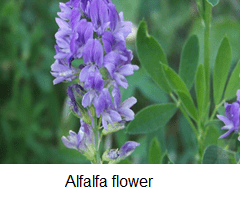Alfalfa silage inoculants: A worldwide meta-analysis
The utilization of microbial additives for the purpose of achieving proper fermentation and improving digestibility has generated great interest, which is evidenced by the fact that inoculants have been developed as silage additives for over 40 years. However, although many studies have reported promising effects of lactic acid bacteria (LAB) inoculation on alfalfa fermentation patterns, responses to silage inoculants are still unclear and could be influenced by several factors. Because of this, we conducted a meta-analysis to quantitatively summarize published research studies that assess the effects of homofermentative lactic acid bacteria (HoLAB) and heterofermentative lactic acid bacteria (HeLAB) on fermentation parameters, nutritive value, microbiological composition and aerobic stability of alfalfa silage.
 A meta-analysis is a highly valuable statistical tool whose objective is to integrate and contrast the results of a large number of primary studies that investigate the same topic. As a result, it generates a more accurate estimate of the effect size of a particular event with greater statistical power than if only one single study had been considered. With this perspective in mind, we screened PubMed, ScienceDirect, and Scopus databases for articles published from 1980 to 2018. The criteria for inclusion were randomized and controlled trials using alfalfa silage and published in peer-reviewed journals. Additionally, we planned a priori sub-group analyses depending on factors that could potentially influence the magnitude of the treatment: 1) year of publication; 2) mono-strain versus multi-strain inoculum; 3) HoLAB versus HeLAB; 4) LAB species used; 5) enzymatic additives; 6) study duration; and 7) silo type.
A meta-analysis is a highly valuable statistical tool whose objective is to integrate and contrast the results of a large number of primary studies that investigate the same topic. As a result, it generates a more accurate estimate of the effect size of a particular event with greater statistical power than if only one single study had been considered. With this perspective in mind, we screened PubMed, ScienceDirect, and Scopus databases for articles published from 1980 to 2018. The criteria for inclusion were randomized and controlled trials using alfalfa silage and published in peer-reviewed journals. Additionally, we planned a priori sub-group analyses depending on factors that could potentially influence the magnitude of the treatment: 1) year of publication; 2) mono-strain versus multi-strain inoculum; 3) HoLAB versus HeLAB; 4) LAB species used; 5) enzymatic additives; 6) study duration; and 7) silo type.
 The final screening of 2173 scientific articles on alfalfa silage inoculants resulted in 48 papers encompassing 131 experiments that were used for the meta-analysis. In the pooled estimate, it was found that inoculation with LAB decreased silage pH, neutral detergent fibre, acid detergent fibre and ammoniacal nitrogen, whereas it increased dry matter and crude protein compared to controls. In contrast, there were no statistical differences in water soluble carbohydrates, in vitro DM digestibility-48 h and ash. Furthermore, LAB inoculation decreased acetate, propionate, ethanol, and butyrate concentrations, while it increased lactate. In addition, inoculants reduced the counts of yeasts and moulds. Lastly, LAB inoculation improved aerobic stability.
The final screening of 2173 scientific articles on alfalfa silage inoculants resulted in 48 papers encompassing 131 experiments that were used for the meta-analysis. In the pooled estimate, it was found that inoculation with LAB decreased silage pH, neutral detergent fibre, acid detergent fibre and ammoniacal nitrogen, whereas it increased dry matter and crude protein compared to controls. In contrast, there were no statistical differences in water soluble carbohydrates, in vitro DM digestibility-48 h and ash. Furthermore, LAB inoculation decreased acetate, propionate, ethanol, and butyrate concentrations, while it increased lactate. In addition, inoculants reduced the counts of yeasts and moulds. Lastly, LAB inoculation improved aerobic stability.
To our knowledge, this is the first meta-analysis that aims at comparing the addition of HoLAB and HeLAB for alfalfa silage. In the pool model, positive effects were found due to the application of microbial silage inoculants in most of the evaluated parameters. Regarding the subgroup analysis, inoculation with HoLAB is recommended as it has been shown to contribute to a lesser loss of nutritional value and to improve the chemical parameters of alfalfa silages, whereas both HoLAB and HeLAB enhanced microbiological composition. In spite of the previous statement, we encourage researchers to conduct further studies to examine the effects of HoLAB and HeLAB with different biotechnological features on digestibility and animal performance.
The article “The role of homofermentative and heterofermentative lactic acid bacteria for alfalfa silage: a meta-analysis” by J. E. Blajman, G. Vinderola, R. B. Páez and M. L. Signorini was published in The Journal of Agricultural Science and is available free for a month.






